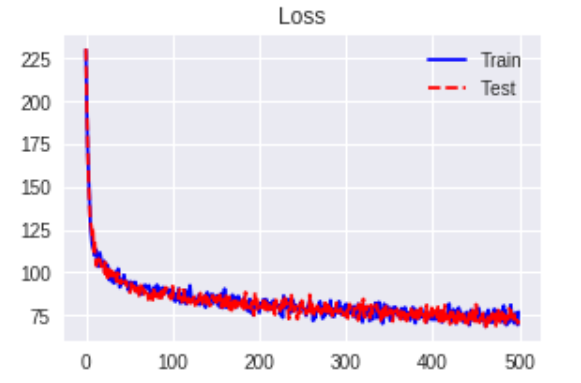ポイント
- Baseline Neural Network を実装し、具体的な数値で確認。
レファレンス
1. Learning Structured Output Representation using Deep Conditional Generative Models
サンプルコード
class BaseLine():
def __init__(self):
pass
def weight_variable(self, name, shape):
initializer = tf.truncated_normal_initializer(mean = 0.0, stddev = 0.01, dtype = tf.float32)
return tf.get_variable(name, shape, initializer = initializer)
def bias_variable(self, name, shape):
initializer = tf.constant_initializer(value = 0.0, dtype = tf.float32)
return tf.get_variable(name, shape, initializer = initializer)
def const_zero(self, name, shape):
initializer = tf.constant_initializer(value = 0.0, dtype = tf.float32)
return tf.get_variable(name, shape, initializer = initializer)
def const_one(self, name, shape):
initializer = tf.constant_initializer(value = 1.0, dtype = tf.float32)
return tf.get_variable(name, shape, initializer = initializer)
def inference(self, x, n_in, n_units_1, n_units_2, n_out):
with tf.variable_scope('mlp'):
w_1 = self.weight_variable('w_1', [n_in, n_units_1])
b_1 = self.bias_variable('b_1', [n_units_1])
h_1 = tf.add(tf.matmul(x, w_1), b_1)
# batch normalization
beta_1 = self.const_zero('beta_1', [n_units_1])
gamma_1 = self.const_one('gamma_1', [n_units_1])
mean_1, var_1 = tf.nn.moments(h_1, [0])
h_1 = gamma_1 * (h_1 - mean_1) / tf.sqrt(var_1 + 1e-5) + beta_1
bn_1 = tf.nn.sigmoid(h_1)
w_2 = self.weight_variable('w_2', [n_units_1, n_units_2])
b_2 = self.bias_variable('b_2', [n_units_2])
h_2 = tf.add(tf.matmul(bn_1, w_2), b_2)
# batch normalization
beta_2 = self.const_zero('beta_2', [n_units_2])
gamma_2 = self.const_one('gamma_2', [n_units_2])
mean_2, var_2 = tf.nn.moments(h_2, [0])
h_2 = gamma_2 * (h_2 - mean_2) / tf.sqrt(var_2 + 1e-5) + beta_2
bn_2 = tf.nn.sigmoid(h_2)
w_3 = self.weight_variable('w_3', [n_units_2, n_out])
b_3 = self.bias_variable('b_3', [n_out])
h_3 = tf.add(tf.matmul(bn_2, w_3), b_3)
return tf.nn.sigmoid(h_3)
def loss(self, y, t):
return - tf.reduce_mean(tf.reduce_sum(t * tf.log(tf.clip_by_value(y, 1e-10, 1.0)) + \
(1 - t) * tf.log(tf.clip_by_value(1 - y, 1e-10, 1.0)), axis = 1))
#return tf.reduce_mean(tf.square(t - y))
def training(self, loss, learning_rate):
optimizer = tf.train.AdamOptimizer(learning_rate = learning_rate)
train_step = optimizer.minimize(loss)
return train_step
def training_clipped(self, loss, learning_rate, clip_norm):
optimizer = tf.train.AdamOptimizer(learning_rate = learning_rate)
grads_and_vars = optimizer.compute_gradients(loss)
clipped_grads_and_vars = [(tf.clip_by_norm(grad, clip_norm = clip_norm), \
var) for grad, var in grads_and_vars]
train_step = optimizer.apply_gradients(clipped_grads_and_vars)
return train_step
def fit(self, images_train_x, images_train_y, labels_train, images_test_x, images_test_y, labels_test, \
n_in, n_units_1, n_units_2, n_out, \
learning_rate, n_iter, batch_size, show_step, is_saving, model_path):
tf.reset_default_graph()
x = tf.placeholder(shape = [None, 14 * 28], dtype = tf.float32)
t = tf.placeholder(shape = [None, 14 * 28], dtype = tf.float32)
y = self.inference(x, n_in, n_units_1, n_units_2, n_out)
loss = self.loss(y, t)
train_step = self.training(loss, learning_rate)
init = tf.global_variables_initializer()
saver = tf.train.Saver()
with tf.Session() as sess:
sess.run(init)
history_loss_train = []
history_loss_test = []
for i in range(n_iter):
# Train
rand_index = np.random.choice(len(images_train_x), size = batch_size)
x_batch = images_train_x[rand_index]
y_batch = images_train_y[rand_index]
feed_dict = {x: x_batch, t: y_batch}
sess.run(train_step, feed_dict = feed_dict)
temp_loss = sess.run(loss, feed_dict = feed_dict)
history_loss_train.append(temp_loss)
if (i + 1) % show_step == 0:
print ('--------------------')
print ('Iteration: ' + str(i + 1) + ' Loss: ' + str(temp_loss))
# Test
rand_index = np.random.choice(len(images_test_x), size = batch_size)
x_batch = images_test_x[rand_index]
y_batch = images_test_y[rand_index]
feed_dict = {x: x_batch, t: y_batch}
temp_loss = sess.run(loss, feed_dict = feed_dict)
history_loss_test.append(temp_loss)
if is_saving:
model_path = saver.save(sess, model_path)
print ('--------------------')
print ('done saving at ', model_path)
fig = plt.figure(figsize = (10, 3))
ax1 = fig.add_subplot(1, 2, 1)
ax1.plot(range(n_iter), history_loss_train, 'b-', label = 'Train')
ax1.plot(range(n_iter), history_loss_test, 'r--', label = 'Test')
ax1.set_title('Loss')
ax1.legend(loc = 'upper right')
plt.show()
def prediction(self, x, n_in, n_units_1, n_units_2, n_out, model_path):
with tf.variable_scope('mlp', reuse = True):
w_1 = self.weight_variable('w_1', [n_in, n_units_1])
b_1 = self.bias_variable('b_1', [n_units_1])
h_1 = tf.add(tf.matmul(x, w_1), b_1)
# batch normalization
beta_1 = self.const_zero('beta_1', [n_units_1])
gamma_1 = self.const_one('gamma_1', [n_units_1])
mean_1, var_1 = tf.nn.moments(h_1, [0])
h_1 = gamma_1 * (h_1 - mean_1) / tf.sqrt(var_1 + 1e-5) + beta_1
bn_1 = tf.nn.sigmoid(h_1)
w_2 = self.weight_variable('w_2', [n_units_1, n_units_2])
b_2 = self.bias_variable('b_2', [n_units_2])
h_2 = tf.add(tf.matmul(bn_1, w_2), b_2)
# batch normalization
beta_2 = self.const_zero('beta_2', [n_units_2])
gamma_2 = self.const_one('gamma_2', [n_units_2])
mean_2, var_2 = tf.nn.moments(h_2, [0])
h_2 = gamma_2 * (h_2 - mean_2) / tf.sqrt(var_2 + 1e-5) + beta_2
bn_2 = tf.nn.sigmoid(h_2)
w_3 = self.weight_variable('w_3', [n_units_2, n_out])
b_3 = self.bias_variable('b_3', [n_out])
h_3 = tf.add(tf.matmul(bn_2, w_3), b_3)
y = tf.nn.sigmoid(h_3)
saver = tf.train.Saver()
with tf.Session() as sess:
saver.restore(sess, model_path)
return sess.run(y)
データ
images_train_x = mnist.train.images[:, :14*28]
images_train_y = mnist.train.images[:, 14*28:]
labels_train = mnist.train.labels
images_test_x = mnist.test.images[:, :14*28]
images_test_y = mnist.test.images[:, 14*28:]
labels_test = mnist.test.labels
パラメータ
n_in = 14*28
n_units_1 = 64
n_units_2 = 64
n_out = 14*28
learning_rate = 0.01
batch_size = 100
アウトプット
index = np.random.choice(10000, batch_size)
x = images_test_x[index]
labels = np.argmax(labels_test[index], axis = 1)
predicts = bl.prediction(x, n_in, n_units_1, n_units_2, n_out, model_path)
print (np.shape(x))
print (np.shape(predicts))
fig = plt.figure(figsize = (4, 1))
ax1 = fig.add_subplot(2, 3, 1)
ax1.imshow(np.reshape(x[0], [14, 28]), cmap = 'gray')
ax1.set_axis_off()
#ax1.set_title('Input')
ax2 = fig.add_subplot(2, 3, 4)
ax2.imshow(np.reshape(predicts[0], [14, 28]), cmap = 'gray')
ax2.set_axis_off()
#ax2.set_title('Predict')
ax3 = fig.add_subplot(2, 3, 2)
ax3.imshow(np.reshape(x[1], [14, 28]), cmap = 'gray')
ax3.set_axis_off()
#ax3.set_title('Input')
ax4 = fig.add_subplot(2, 3, 5)
ax4.imshow(np.reshape(predicts[1], [14, 28]), cmap = 'gray')
ax4.set_axis_off()
#ax4.set_title('Predict')
ax5 = fig.add_subplot(2, 3, 3)
ax5.imshow(np.reshape(x[2], [14, 28]), cmap = 'gray')
ax5.set_axis_off()
#ax5.set_title('Input')
ax6 = fig.add_subplot(2, 3, 6)
ax6.imshow(np.reshape(predicts[2], [14, 28]), cmap = 'gray')
ax6.set_axis_off()
#ax6.set_title('Predict')
plt.show()

